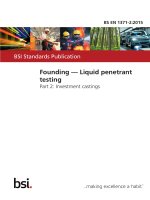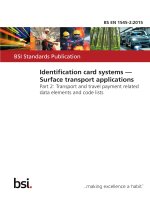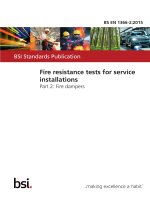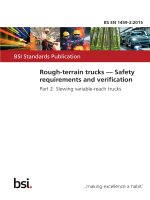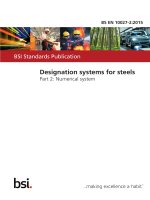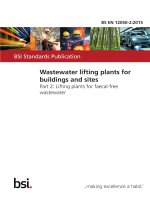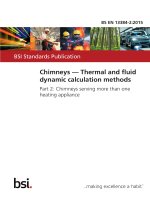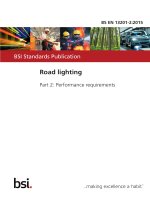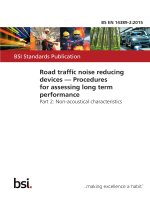Bsi bs en 61189 2 721 2015
Bạn đang xem bản rút gọn của tài liệu. Xem và tải ngay bản đầy đủ của tài liệu tại đây (1.79 MB, 28 trang )
BS EN 61189-2-721:2015
BSI Standards Publication
Test methods for electrical
materials, printed boards
and other interconnection
structures and assemblies
Part 2-721: Test methods for materials for
interconnection structures — Measurement
of relative permittivity and loss tangent for
copper clad laminate at microwave frequency
using split post dielectric resonator
BRITISH STANDARD
BS EN 61189-2-721:2015
National foreword
This British Standard is the UK implementation of EN 61189-2-721:2015. It
is identical to IEC 61189-2-721:2015.
The UK participation in its preparation was entrusted to Technical
Committee EPL/501, Electronic Assembly Technology.
A list of organizations represented on this committee can be obtained on
request to its secretary.
This publication does not purport to include all the necessary provisions of
a contract. Users are responsible for its correct application.
© The British Standards Institution 2015.
Published by BSI Standards Limited 2015
ISBN 978 0 580 83821 7
ICS 31.180
Compliance with a British Standard cannot confer immunity from
legal obligations.
This British Standard was published under the authority of the
Standards Policy and Strategy Committee on 30 June 2015.
Amendments/corrigenda issued since publication
Date
Text affected
EUROPEAN STANDARD
EN 61189-2-721
NORME EUROPÉENNE
EUROPÄISCHE NORM
June 2015
ICS 31.180
English Version
Test methods for electrical materials, printed boards and other
interconnection structures and assemblies - Part 2-721: Test
methods for materials for interconnection structures Measurement of relative permittivity and loss tangent for copper
clad laminate at microwave frequency using split post dielectric
resonator
(IEC 61189-2-721:2015)
Méthodes d'essai pour les matériaux électriques, les cartes
imprimées et autres structures d'interconnexion et
ensembles - Partie 2-721: Méthodes d'essai des matériaux
pour structures d'interconnexion - Mesure de la permittivité
relative et de la tangente de perte pour les stratifiés
recouverts de cuivre en hyperfréquences à l'aide d'un
résonateur diélectrique en anneaux fendus
(IEC 61189-2-721:2015)
Prüfverfahren für Elektromaterialien, Leiterplatten und
andere Verbindungsstrukturen und Baugruppen - Teil 2721: Prüfverfahren für Verbindungsstrukturen (Leiterplatten)
- Messung der relativen Permittivität und des Verlustfaktors
von kupferkaschiertem Laminat im MikrowellenFrequenzbereich unter Verwendung eines Split Post
dielektrischen Resonators
(IEC 61189-2-721:2015)
This European Standard was approved by CENELEC on 2015-06-03. CENELEC members are bound to comply with the CEN/CENELEC
Internal Regulations which stipulate the conditions for giving this European Standard the status of a national standard without any alteration.
Up-to-date lists and bibliographical references concerning such national standards may be obtained on application to the CEN-CENELEC
Management Centre or to any CENELEC member.
This European Standard exists in three official versions (English, French, German). A version in any other language made by translation
under the responsibility of a CENELEC member into its own language and notified to the CEN-CENELEC Management Centre has the
same status as the official versions.
CENELEC members are the national electrotechnical committees of Austria, Belgium, Bulgaria, Croatia, Cyprus, the Czech Republic,
Denmark, Estonia, Finland, Former Yugoslav Republic of Macedonia, France, Germany, Greece, Hungary, Iceland, Ireland, Italy, Latvia,
Lithuania, Luxembourg, Malta, the Netherlands, Norway, Poland, Portugal, Romania, Slovakia, Slovenia, Spain, Sweden, Switzerland,
Turkey and the United Kingdom.
European Committee for Electrotechnical Standardization
Comité Européen de Normalisation Electrotechnique
Europäisches Komitee für Elektrotechnische Normung
CEN-CENELEC Management Centre: Avenue Marnix 17, B-1000 Brussels
© 2015 CENELEC All rights of exploitation in any form and by any means reserved worldwide for CENELEC Members.
Ref. No. EN 61189-2-721:2015 E
BS EN 61189-2-721:2015
EN 61189-2-721:2015
European foreword
The text of document 91/1246/FDIS, future edition 1 of IEC 61189-2-721, prepared by
IEC/TC 91 "Electronics assembly technology" was submitted to the IEC-CENELEC parallel vote and
approved by CENELEC as EN 61189-2-721:2015.
The following dates are fixed:
•
latest date by which the document has to be
implemented at national level by
publication of an identical national
standard or by endorsement
(dop)
2016-03-03
•
latest date by which the national
standards conflicting with the
document have to be withdrawn
(dow)
2018-06-03
Attention is drawn to the possibility that some of the elements of this document may be the subject of
patent rights. CENELEC [and/or CEN] shall not be held responsible for identifying any or all such
patent rights.
Endorsement notice
The text of the International Standard IEC 61189-2-721:2015 was approved by CENELEC as a
European Standard without any modification.
2
–2–
BS EN 61189-2-721:2015
IEC 61189-2-721:2015 © IEC 2015
CONTENTS
FOREWORD ........................................................................................................................... 4
1
Scope .............................................................................................................................. 6
2
Test specimens ............................................................................................................... 6
2.1
Specimen size ........................................................................................................ 6
2.2
Preparation ............................................................................................................. 7
2.3
Marking ................................................................................................................... 7
2.4
Thickness ............................................................................................................... 7
3
Equipment/apparatus ....................................................................................................... 7
3.1
General ................................................................................................................... 7
3.2
Vector network analyzer (VNA) ............................................................................... 8
3.3
SPDR test fixture .................................................................................................... 8
3.3.1
General ........................................................................................................... 8
3.3.2
Parameters ...................................................................................................... 8
3.3.3
Frequency ....................................................................................................... 8
3.4
Verify unit ............................................................................................................... 9
3.5
Micrometer .............................................................................................................. 9
3.6
Circulating oven ...................................................................................................... 9
3.7
Test chamber .......................................................................................................... 9
4
Procedure ........................................................................................................................ 9
4.1
Preconditioning ....................................................................................................... 9
4.2
Testing of relative permittivity and loss tangent at room temperature ...................... 9
4.2.1
Test conditions ................................................................................................ 9
4.2.2
Preparation ...................................................................................................... 9
4.2.3
Fixture ........................................................................................................... 10
4.2.4
Connection to VNA ........................................................................................ 10
4.2.5
VNA parameter .............................................................................................. 10
4.2.6
Frequency and Q-factor without specimen ..................................................... 10
4.2.7
Micrometer .................................................................................................... 10
4.2.8
Setting the specimen ..................................................................................... 10
4.2.9
Frequency and Q-factor with specimen .......................................................... 10
4.2.10
Comparison ................................................................................................... 10
4.2.11
Calculation .................................................................................................... 11
4.2.12
Change the specimen .................................................................................... 12
4.2.13
Change in test frequency ............................................................................... 12
4.3
Testing of relative permittivity and loss tangent at variable temperatures .............. 12
4.3.1
Test conditions .............................................................................................. 12
4.3.2
Preparation .................................................................................................... 12
4.3.3
Fixture ........................................................................................................... 12
4.3.4
Connection to VNA ........................................................................................ 12
4.3.5
VNA parameter .............................................................................................. 12
4.3.6
Temperature in the chamber .......................................................................... 12
4.3.7
Frequency and Q-factor without specimen ..................................................... 12
4.3.8
Micrometer .................................................................................................... 12
4.3.9
Setting of the specimen ................................................................................. 13
4.3.10
Frequency and Q-factor with specimen .......................................................... 13
4.3.11
Calculation .................................................................................................... 13
BS EN 61189-2-721:2015
IEC 61189-2-721:2015 © IEC 2015
5
–3–
4.3.12
Options .......................................................................................................... 13
4.3.13
Thermal coefficient ........................................................................................ 13
4.3.14
Change in test frequency ............................................................................... 14
Report ........................................................................................................................... 14
5.1
At room temperature ............................................................................................. 14
5.2
At variable temperature ......................................................................................... 14
6
Additional information .................................................................................................... 14
6.1
6.2
6.3
6.4
Accuracy ............................................................................................................... 14
Maintenance ......................................................................................................... 14
Matters to be attended .......................................................................................... 15
Additional information concerning fixtures and results ........................................... 15
6.5
Additional information on K ε (ε r ,h) and p es ............................................................. 15
Annex A (informative) Example of test fixture and test result ................................................ 16
A.1
Example of test fixture .......................................................................................... 16
A.2
Example of test result ........................................................................................... 16
Annex B (informative) Additional information on K ε (ε r ,h) and p es ........................................ 19
Bibliography .......................................................................................................................... 22
Figure 1 – Scheme of SPDR test fixture .................................................................................. 6
Figure 2 – Component diagram of test system ........................................................................ 8
Figure 3 – Scheme of the change of resonance frequency with or without the
specimen .............................................................................................................................. 10
Figure A.1 – Test fixture ....................................................................................................... 16
Figure A.2 – Relative permittivity versus frequency (laminate of Dk 3,8 and thickness
0,51 mm) .............................................................................................................................. 17
Figure A.3 – Loss tangent versus frequency (laminate of Dk 3,8 and thickness
0,51 mm) .............................................................................................................................. 17
Figure A.4 – Curve of relative permittivity and loss tangent at variable temperatures
(laminate of Dk 3,8 and thickness 0,51 mm) .......................................................................... 18
Figure B.1 – K ε (ε r ,h) versus relative permittivity at different sample thicknesses .................. 19
Figure B.2 – Distribution of the electric field of the split dielectric resonator (side view
of the dielectric resonators) .................................................................................................. 20
Figure B.3 – Distribution of the electric field of the split dielectric resonator (top view
between the dielectric resonators) ........................................................................................ 21
Figure B.4 – p es versus relative permittivity at different sample thicknesses ......................... 21
Table 1 – Specimen dimensions ............................................................................................. 7
Table 2 – SPDR test fixture’s parameter ................................................................................. 9
Table B.1 – Results of measurements of different materials using a 10 GHz SPDR.............. 20
BS EN 61189-2-721:2015
IEC 61189-2-721:2015 © IEC 2015
–4–
INTERNATIONAL ELECTROTECHNICAL COMMISSION
____________
TEST METHODS FOR ELECTRICAL MATERIALS, PRINTED BOARDS AND
OTHER INTERCONNECTION STRUCTURES AND ASSEMBLIES –
Part 2-721: Test methods for materials for interconnection structures –
Measurement of relative permittivity and loss tangent for copper clad
laminate at microwave frequency using split post dielectric resonator
FOREWORD
1) The International Electrotechnical Commission (IEC) is a worldwide organization for standardization comprising
all national electrotechnical committees (IEC National Committees). The object of IEC is to promote
international co-operation on all questions concerning standardization in the electrical and electronic fields. To
this end and in addition to other activities, IEC publishes International Standards, Technical Specifications,
Technical Reports, Publicly Available Specifications (PAS) and Guides (hereafter referred to as “IEC
Publication(s)”). Their preparation is entrusted to technical committees; any IEC National Committee interested
in the subject dealt with may participate in this preparatory work. International, governmental and nongovernmental organizations liaising with the IEC also participate in this preparation. IEC collaborates closely
with the International Organization for Standardization (ISO) in accordance with conditions determined by
agreement between the two organizations.
2) The formal decisions or agreements of IEC on technical matters express, as nearly as possible, an international
consensus of opinion on the relevant subjects since each technical committee has representation from all
interested IEC National Committees.
3) IEC Publications have the form of recommendations for international use and are accepted by IEC National
Committees in that sense. While all reasonable efforts are made to ensure that the technical content of IEC
Publications is accurate, IEC cannot be held responsible for the way in which they are used or for any
misinterpretation by any end user.
4) In order to promote international uniformity, IEC National Committees undertake to apply IEC Publications
transparently to the maximum extent possible in their national and regional publications. Any divergence
between any IEC Publication and the corresponding national or regional publication shall be clearly indicated in
the latter.
5) IEC itself does not provide any attestation of conformity. Independent certification bodies provide conformity
assessment services and, in some areas, access to IEC marks of conformity. IEC is not responsible for any
services carried out by independent certification bodies.
6) All users should ensure that they have the latest edition of this publication.
7) No liability shall attach to IEC or its directors, employees, servants or agents including individual experts and
members of its technical committees and IEC National Committees for any personal injury, property damage or
other damage of any nature whatsoever, whether direct or indirect, or for costs (including legal fees) and
expenses arising out of the publication, use of, or reliance upon, this IEC Publication or any other IEC
Publications.
8) Attention is drawn to the Normative references cited in this publication. Use of the referenced publications is
indispensable for the correct application of this publication.
9) Attention is drawn to the possibility that some of the elements of this IEC Publication may be the subject of
patent rights. IEC shall not be held responsible for identifying any or all such patent rights.
International Standard IEC 61189-2-721 has been prepared by IEC technical committee 91:
Electronics assembly technology.
The text of this standard is based on the following documents:
FDIS
Report on voting
91/1246/FDIS
91/1258/RVD
Full information on the voting for the approval of this standard can be found in the report on
voting indicated in the above table.
BS EN 61189-2-721:2015
IEC 61189-2-721:2015 © IEC 2015
–5–
A list of all parts in the IEC 61189 series, published under the general title Test methods for
electrical materials, printed boards and other interconnection structures and assemblies, can
be found on the IEC website.
Future standards in this series will carry the new general title as cited above. Titles of existing
standards in this series will be updated at the time of the next edition.
This publication has been drafted in accordance with the ISO/IEC Directives, Part 2.
The committee has decided that the contents of this publication will remain unchanged until
the stability date indicated on the IEC website under "" in the data
related to the specific publication. At this date, the publication will be
•
reconfirmed,
•
withdrawn,
•
replaced by a revised edition, or
•
amended.
IMPORTANT – The 'colour inside' logo on the cover page of this publication indicates
that it contains colours which are considered to be useful for the correct
understanding of its contents. Users should therefore print this document using a
colour printer.
–6–
BS EN 61189-2-721:2015
IEC 61189-2-721:2015 © IEC 2015
TEST METHODS FOR ELECTRICAL MATERIALS, PRINTED BOARDS AND
OTHER INTERCONNECTION STRUCTURES AND ASSEMBLIES –
Part 2-721: Test methods for materials for interconnection structures –
Measurement of relative permittivity and loss tangent for copper clad
laminate at microwave frequency using split post dielectric resonator
1
Scope
This part of IEC 61189 outlines a way to determine the relative permittivity ( ε r ) and loss
tangent (tan δ ) (also called dielectric constant (Dk) and dissipation factor (Df)) of copper clad
laminates at microwave frequencies (from 1,1 GHz to 20 GHz) using a split post dielectric
resonator (SPDR).
This part of IEC 61189 is applicable to copper clad laminates and dielectric base materials.
2
Test specimens
2.1
Specimen size
The size of the specimen shall be larger than the internal diameter D of the metal enclosures,
and the maximum thickness of the specimen shall be smaller than the distance h g between
the metal enclosures of the fixture. (See Figure 1.)
Support
D
Z
Dielectric resonators
L
hg
hr
Coupling loop
Sample
dr
Metal enclosure
Key
h g distance between the metal enclosures of the fixture;
D
internal diameter of the metal enclosures;
L
internal height of the metal enclosures;
dr
diameter of the dielectric resonator;
hr
thickness of the dielectric resonator.
Figure 1 – Scheme of SPDR test fixture
IEC
BS EN 61189-2-721:2015
IEC 61189-2-721:2015 © IEC 2015
–7–
Three specimens for the test at room temperature and one specimen for the test at variable
temperatures are required for each SPDR test fixture for this test. Table 1 shows the
supported specimen dimensions.
Table 1 – Specimen dimensions
SPDR test fixture’s nominal
frequency
Supported specimen sizes
Maximum thickness of specimens
GHz
mm
mm
1,1
150 × 150
6,0
3
80 × 80
3,0
5 to 6
80 × 80
2,0
9 to 10
80 × 80
0,9
13 to 16
50 × 35
0,6
18 to 20
15 × 15
0,5
If applicable, a specimen size different from those given in Table 1 can be used. For example,
specimen size “130 mm × 130 mm” can be used for 1,1 GHz.
2.2
Preparation
Copper clad laminates shall have all copper cladding removed by etching, and shall be
thoroughly cleaned.
2.3
Marking
Mark each specimen in the upper left corner with an engraving pencil or other suitable method.
2.4
Thickness
Within the limits of the test fixture, the thicker the specimen is, the less error occurs in the
measurements. Thin specimen can be stacked up to a minimum of 0,4 mm to improve
measurement accuracy.
NOTE
3
3.1
Air gaps between the sample and fixture do not affect the measurement.
Equipment/apparatus
General
The component diagram of the test system is shown in Figure 2.
BS EN 61189-2-721:2015
IEC 61189-2-721:2015 © IEC 2015
–8–
Room temperature test
Variable temperature test
VNA
VNA
Environmental test chamber
SPDR test fixture
Sample
Sample
SPDR test fixture
IEC
Figure 2 – Component diagram of test system
3.2
Vector network analyzer (VNA)
The following values are required:
a) The frequency range of VNA shall be 500 MHz to 20 GHz.
b) The dynamic range of VNA shall be more than 60 dB.
3.3
3.3.1
SPDR test fixture
General
Figure 1 shows the scheme of SPDR test fixture.
3.3.2
Parameters
Table 2 shows the typical relationship between the SPDR test fixture’s nominal frequency and
h g and D.
3.3.3
Frequency
For different test frequencies, use a corresponding SPDR test fixture of nominal frequency.
BS EN 61189-2-721:2015
IEC 61189-2-721:2015 © IEC 2015
–9–
Table 2 – SPDR test fixture’s parameter
3.4
SPDR test fixture’s nominal frequency
D
hg
GHz
mm
mm
1,1
120
6,0
3
50
3,0
5 to 6
30
2,0
9 to 10
22
0,9
13 to 16
15
0,6
18 to 20
10
0,5
Verify unit
The verify unit includes the following:
a) Standard reference sample, for example, single-crystal quartz or equivalent sample.
b) A calibration assembly of VNA.
3.5
Micrometer
Micrometer with 0,001 mm resolution (or better).
3.6
Circulating oven
Circulating oven with stabilized temperature at 105 +−52 °C.
3.7
Test chamber
For the environmental test chamber for
requirements apply:
variable temperature
testing
the following
a) Temperature ranges: –125 °C to +110 °C, other temperature range is as agreed between
user and supplier.
b) Temperature accuracy-set point to actual: ±1 °C.
4
Procedure
4.1
Preconditioning
All specimens shall be conditioned at (23 ± 2) °C and (50 ± 5) % RH for at least 24 h prior to
testing. However, if a specimen has recently been etched or exposed to excessive moisture, it
should be dried in an air-circulating oven for 2 h at 105 +−52 °C and then conditioned at the
condition as mentioned above.
4.2
4.2.1
Testing of relative permittivity and loss tangent at room temperature
Test conditions
The ambient test temperature should be (23 ± 2) °C. The variation should not exceed 1 °C
during the test.
4.2.2
Preparation
Allow at least 30 min for the VNA to warm up and stabilize.
– 10 –
4.2.3
BS EN 61189-2-721:2015
IEC 61189-2-721:2015 © IEC 2015
Fixture
Select an SPDR test fixture in accordance with the test frequency. The specimen size and
thickness shall comply with the requirements specified in Table 1. For example, if the test
frequency is 10 GHz, a SPDR test fixture with 10 GHz nominal frequency should be selected.
The supported specimen size is 80 mm × 80 mm and the maximum thickness of specimens is
no more than 0,9 mm.
4.2.4
Connection to VNA
Connect the SPDR test fixture to the VNA. The test fixture shall be kept horizontal.
4.2.5
VNA parameter
Set the VNA parameters according to the manufacturer's instructions and the nominal
frequency of the SPDR fixture.
4.2.6
Frequency and Q-factor without specimen
Measure the resonance frequency (f 0 ) and Q-factor (Q 0 ) values of the empty resonator.
4.2.7
Micrometer
Utilize a micrometer to measure the thickness of the specimen and record as h.
4.2.8
Setting the specimen
Insert the specimen into the test fixture. The side with marking is face up and the edge of this
side has to be aligned with the fixture edge.
4.2.9
Frequency and Q-factor with specimen
Measure the resonance frequency (f s ) and Q-factor (Q s ) of the resonator containing the
specimen.
4.2.10
Comparison
Resonance amplitude
The scheme of the change of resonance frequency with or without the specimen is shown in
Figure 3.
Resonator containing
the specimen
fS
Empty resonator
f0
Resonance frequency
IEC
Figure 3 – Scheme of the change of resonance frequency
with or without the specimen
BS EN 61189-2-721:2015
IEC 61189-2-721:2015 © IEC 2015
4.2.11
4.2.11.1
– 11 –
Calculation
General
Calculation of relative permittivity and loss tangent at room temperature.
Relative permittivity and loss tangent at room temperature shall be calculated as follows. It is
recommended to use the computer software provided by the equipment supplier for
calculation.
4.2.11.2
Relative permittivity
The relative permittivity ( ε r ) shall be calculated according to Equation (1).
εr = 1+
f0 − fs
hf 0 K ε (ε r , h )
(1)
where
εr
is relative permittivity;
h
is the thickness of the specimen under test, in mm;
f0
is the resonant frequency of the empty SPDR;
fs
is the resonant frequency of the resonator with the dielectric specimen;
K ε ( ε r, h)
is a function of ε r and h. For a fixed resonant cavity, its physical parameters (size,
dielectric resonators ε r ) should have been identified. K ε ( ε r, h) is pre-computed and
tabulated by electromagnetic field simulation with the strict Rayleigh-Ritz method.
Put the empty SPDR frequency (f 0 ), the resonant frequency with dielectric
specimen (f s ) and the thickness of the specimen (h) under test into Equation (1).
Enter a similar arbitrary value of the relative permittivity of the sample, and use a
successive approximation algorithm. After several iterations, end the calculation
when the relative error of the last two calculated relative permittivities is less than
0,1 %. The last calculated data is taken as the relative permittivity of the specimen.
Some additional information is shown in Annex B.
4.2.11.3
Loss tangent
The loss tangent shall be calculated according to Equation (2).
tan δ =
(Q
S
−1
− QDR −1 − QC −1
p es
)
(2)
where
tan δ
is the loss tangent;
Qs
is the unloaded Q-factor of a resonant fixture containing the specimen;
Qc
is the Q-factor depending on metal losses for the resonant fixture containing the
specimen;
Q DR
is the Q-factor depending on dielectric losses in the dielectric posts for the fixture
containing the specimen;
p es
is the electromagnetic energy filling factor of the specimen. After identifying the
physical parameters of the resonant cavity, the electromagnetic energy filling factor
p es can be determined by electromagnetic field simulation. For a fixed resonant
cavity, p es is a constant value. Some additional information is showed in Annex B.
– 12 –
4.2.12
BS EN 61189-2-721:2015
IEC 61189-2-721:2015 © IEC 2015
Change the specimen
Measure the two remaining specimens by repeating steps 4.2.6 through 4.2.11.
4.2.13
Change in test frequency
If another test frequency is selected, change the SPDR test fixture in accordance with the test
frequency. Then repeat steps 4.2.3 through 4.2.12.
4.3
4.3.1
Testing of relative permittivity and loss tangent at variable temperatures
Test conditions
The ambient test temperature should be (23 ± 2) °C. The variation should not exceed 1 °C
during the test.
4.3.2
Preparation
Allow at least 30 min for the VNA to warm up.
4.3.3
Fixture
Select an SPDR test fixture in accordance with the test frequency. The specimen size and
thickness shall comply with the requirements specified in Table 1. For example, if the test
frequency is 10 GHz, an SPDR test fixture with 10 GHz nominal frequency should be selected.
The supported specimen size is 80 mm × 80 mm and the maximum thickness of the specimen
is no more than 0,9 mm.
4.3.4
Connection to VNA
Connect the SPDR test fixture to the VNA. The test fixture shall be kept in a horizontal
position in the test chamber.
4.3.5
VNA parameter
Set the VNA parameters according to the manufacturer's instructions and the nominal
frequency of the SPDR fixture.
4.3.6
Temperature in the chamber
Adjust the test temperature of the test chamber. After reaching the set temperature (T), hold it
for at least 15 min.
4.3.7
Frequency and Q-factor without specimen
Measure the resonance frequency f 0 (T) and Q-factor Q 0 (T) of the empty resonator.
The resonance peak should be between –40 dB and –45 dB; adjust the position of the
coupling loops to achieve this whilst ensuring their position is symmetrical.
When measuring the Q-factor, the frequency span of the VNA should be adjusted such that it
is between 110 % and 200 % of the full width at half maximum of the resonant curve.
4.3.8
Micrometer
Use a micrometer to measure the thickness of the specimen, and record as h.
BS EN 61189-2-721:2015
IEC 61189-2-721:2015 © IEC 2015
4.3.9
– 13 –
Setting of the specimen
The environmental test chamber shall be returned to room temperature. Insert the specimen
into the test fixture. The side with marking is face up and the edge of this side has to be
aligned with the fixture edge.
4.3.10
Frequency and Q-factor with specimen
Repeat step 4.3.6. Measure the resonance frequency f s (T) and Q-factor Q s (T) of the resonator
with the specimen at temperature T.
When measuring the Q-factor, the frequency span of the VNA should be adjusted such that it
is between 110 % and 200 % of the full width at half maximum of the resonant curve.
4.3.11
Calculation
Follow step 4.2.11 and calculate the value of the relative permittivity Dk(T) and the loss
tangent Df(T) at temperature T.
4.3.12
Options
If another test temperature is selected, repeat steps 4.3.6 through 4.3.11.
4.3.13
4.3.13.1
Thermal coefficient
General
Thermal coefficient of relative permittivity and thermal coefficient of loss tangent.
4.3.13.2
Relative permittivity
The thermal coefficient of the relative permittivity ε r (brief for TC ε r ) is the change rate of the
relative permittivity per temperature change. The unit of TC ε r is 10 –6 /°C. Generally, the
relative permittivity of a specimen at its base temperature T ref of 23 °C is used as the base
relative permittivity Dk(T ref ). For temperature T, TC ε r shall be calculated according to Equation
(3).
TCe r =
Dk (T ) − Dk (Tref )
(T − Tref ) × Dk (Tref )
(3)
where
T
is the thermal coefficient of ε r , 10 –6 /°C;
is the test temperature, in °C;
T ref
is the base temperature, in °C;
Dk(T)
is the relative permittivity at temperature T ;
Dk(T ref )
is the relative permittivity at temperature T ref .
TC ε r
4.3.13.3
Loss tangent
The Thermal coefficient of tan δ (TC tan δ ) is the change rate of the loss tangent per
temperature (every increase or decrease 1 °C). The unit of TC tan δ is 10 –6 /°C. Generally, the
loss tangent of the specimen at base temperature T ref of 23 °C is used as the base loss
tangent Df(T ref ). For temperature T, TC tan δ is calculated according to Equation (4).
TC tan δ =
Df (T ) − Df (Tref )
(T − Tref ) × Df (Tref )
(4)
– 14 –
BS EN 61189-2-721:2015
IEC 61189-2-721:2015 © IEC 2015
where
TC tan δ
is thermal coefficient of tan δ , in ppm/°C;
T
is the test temperature, in °C;
T ref
is the base temperature, in °C;
Df(T)
is the loss tangent at temperature T;
Df(T ref )
is the loss tangent at temperature T ref .
4.3.14
Change in test frequency
If another test frequency is selected, change the SPDR test fixture in accordance with the test
frequency. Then repeat steps 4.3.3 through 4.3.13.
5
5.1
Report
At room temperature
For room temperature tests, report the following:
a) test environment (temperature, humidity);
b) test frequency;
c) the values and the average values of the relative permittivity and loss tangent at test
frequency;
d) the preconditioning of the specimen;
e) any anomalies in the test or variations from this test method.
5.2
At variable temperature
For variable temperature tests, report the following:
a) test temperature (T) and base temperature (T ref );;
b) test frequency;
c) Dk(T)and Df(T)at test temperature (T);
d) TC ε r and TC tan δ ;
e) Dk(T ref ) and Df(T ref );
f)
if more than one test temperature is necessary, report the curve diagram of the relative
permittivity and loss tangent in accordance with the temperature variation;
g) the preconditioning of the specimen;
h) any anomalies in the test or variations from this test method.
6
6.1
Additional information
Accuracy
Accuracy of measurements of a sample of thickness h.
Permittivity measurement: ∆ ε / ε = ±(0,0015+∆h/h).
Loss tangent: ∆tan δ = ±2 × 10 −5 or ±0,03 tan δ whichever is higher.
6.2
Maintenance
Clean the test heads, standard materials and fixtures regularly.
BS EN 61189-2-721:2015
IEC 61189-2-721:2015 © IEC 2015
6.3
– 15 –
Matters to be attended
To prevent damage to the test fixture because of the variable temperature tests, verify the
test system regularly with a standard reference sample. For example, single-crystal quartz is
used as the standard reference sample of thickness 0,4 mm. The deviation of the relative
permittivity measurement between the test result and the nominal value of the standard
reference sample shall be less than ±0,7 %, while the deviation of the loss tangent shall be
less than ±2 × 10 −5 .
6.4
Additional information concerning fixtures and results
An example of a test fixture and test result is shown in Annex A.
6.5
Additional information on K ε ( ε r ,h) and p es
Some additional information on K ε ( ε r ,h) and p es is shown in Annex B.
– 16 –
BS EN 61189-2-721:2015
IEC 61189-2-721:2015 © IEC 2015
Annex A
(informative)
Example of test fixture and test result
A.1
Example of test fixture
Figure A.1 shows a picture of an SPDR fixture at 5 GHz. Utilize a 3,5 mm female-to-female
adapter to connect the coaxial cable and the SPDR test fixture.
An SPDR fixture has a coupling loop on both ends to adjust the coupling coefficient. The
maximum thickness of the specimen of this fixture is 2 mm.
Coupling loop
Marking
Coupling loop
IEC
Figure A.1 – Test fixture
A.2
Example of test result
Figure A.2 and Figure A.3 show the typical measurement of relative permittivity and loss
tangent at microwave frequencies (from 1,1 GHz to 19 GHz) for a copper clad laminate of ε r
3,8. Figure A.4 shows the curve diagram of relative permittivity and loss tangent at variable
temperatures (from −125 °C to 110 °C) for a copper clad laminate of ε r 3,8.
Relative permittivity
BS EN 61189-2-721:2015
IEC 61189-2-721:2015 © IEC 2015
– 17 –
4,0
DK 3,8
3,9
3,8
3,7
3,6
3,5
0
2
4
6
8
10
12
14
16
18
20
Frequency, GHz
IEC
Loss tangent
Figure A.2 – Relative permittivity versus frequency
(laminate of Dk 3,8 and thickness 0,51 mm)
0,010
Df
0,009
0,008
0,007
0
2
4
6
8
10
12
14
16
18
20
Frequency, GHz
IEC
Figure A.3 – Loss tangent versus frequency
(laminate of Dk 3,8 and thickness 0,51 mm)
Relative permittivity
– 18 –
3,92
0,014
0,012
3,88
Loss tangent
BS EN 61189-2-721:2015
IEC 61189-2-721:2015 © IEC 2015
0,010
3,84
0,008
0,006
3,80
0,004
Dk
3,76
0,002
Df
3,72
−150
−100
−50
0
Temperature,
°C
50
100
0,000
150
IEC
Figure A.4 – Curve of relative permittivity and loss tangent
at variable temperatures (laminate of Dk 3,8 and thickness 0,51 mm)
BS EN 61189-2-721:2015
IEC 61189-2-721:2015 © IEC 2015
– 19 –
Annex B
(informative)
Additional information on K ε ( ε r,h) and p es
By definition K ε ( ε r ,h) function values are specified for a given resonant fixture and with fixed
values ε r and h as follows:
K ε (ε r , h ) =
f0 − fs
(ε r − 1)hf 0
(B.1)
K ε ( ε r ,h)
The function K ε ( ε r ,h) is computed and tabulated for every specific SPDR. Exact resonant
frequencies and the resulting values of K ε ( ε r ,h) are computed for a number of ε r and h and
tabulated. Interpolation has been used to compute K ε ( ε r ,h) for any other values of ε r and h.
The initial value of K ε ( ε r ,h) in the permittivity evaluation using Equation (1) is taken to be the
same as its corresponding value for a given h and ε r = 1. Subsequent values of K ε ( ε r ,h) are
found for the subsequent dielectric constant values obtained in the iterative procedure.
Because K ε ( ε r ,h) is a slowly varying function of ε r and h, the iterations using Equation (1)
converge rapidly. Figure B.1 shows K ε ( ε r ,h) versus relative permittivity at different sample
thicknesses for a 10 GHz SPDR.
12,6
h = 0,1 mm
12,5
h = 0,3 mm
12,4
h = 0,5 mm
12,3
h = 0,7 mm
h = 0,9 mm
12,2
12,1
2
4
6
8
10
12
14
εr
IEC
Figure B.1 – K ε ( ε r ,h) versus relative permittivity at
different sample thicknesses
By definition the p es value is specified for a given resonant fixture and with fixed values ε′ r
and h as follows:
p es = h e
r′ K1 ( r′ , h )
(B.2)
BS EN 61189-2-721:2015
IEC 61189-2-721:2015 © IEC 2015
– 20 –
where
ε′ r
is the relative permittivity;
h
is the thickness of the specimen, mm;
K 1 ( ε′ r ,h)
is a function of ε′ r and h.
The Rayleigh-Ritz method permits to compute the p es value for a given resonant structure.
These parameters have been computed for a number of h and ε′ r .
For a 10 GHz SPDR with resonant structure D = 16,5 mm, L = 9 mm, d r = 8 mm, h r = 1 mm, h g
= 1 mm and a relative permittivity of a dielectric resonator = 38, the distribution of the electric
field component E in the split dielectric resonator operating at a nominal frequency (without
sample) of 10 GHz is shown in Figure B.2 and Figure B.3.
Figure B.4 shows p es versus relative permittivity at different sample thicknesses.
For a 10 GHz SPDR with different samples, the parameters are shown in Table B.1.
Table B.1 – Results of measurements of
different materials using a 10 GHz SPDR
Dk
Df
Thickness
mm
p es
K ε ( ε r , h)
Qc
Q DR
Material
2,05
0,000 3
0,3
8,3 × 10 –4
12,477
> 10 5
16 000
PTFE
3,0
0,003 0
0,3
1,2 × 10 –3
12,412
> 10 5
16 000
Low-Dk FR4
3,8
0,009 0
0,3
3 × 10 –3
12,364
> 10 5
16 000
Low-loss FR4
12,332
10 5
16 000
Halogen-free FR4
4,5
0,015 0
0,3
4,2 × 10
–3
>
IEC
Figure B.2 – Distribution of the electric field of the split dielectric resonator
(side view of the dielectric resonators)
BS EN 61189-2-721:2015
IEC 61189-2-721:2015 © IEC 2015
– 21 –
IEC
p es
Figure B.3 – Distribution of the electric field of the split dielectric resonator
(top view between the dielectric resonators)
1
h = 0,8 mm
0,1
h = 0,4 mm
0,01
h = 0,2 mm
h = 0,1 mm
10 -3
10 -4
0
20
40
60
80
100
Relative permittivity
IEC
Figure B.4 – p es versus relative permittivity at different sample thicknesses
– 22 –
BS EN 61189-2-721:2015
IEC 61189-2-721:2015 © IEC 2015
Bibliography
[1]
Nishikawa, T.; Wakino, K.; Tanaka, H.; Ishikawa, Y., "Dielectric Resonator Method for
Nondestructive Measurement of Complex Permittivity of Microwave Dielectric
Substrates," Microwave Conference, 1990. 20th European, vol.1, pp.501-506, 1990
[2]
Mazierska, J.; Krupka, J.; Jacob, M.V.; Ledenyov, D., "Complex permittivity
measurements at variable temperatures of low loss dielectric substrates employing split
post and single post dielectric resonators," Microwave Symposium Digest, 2004 IEEE
MTT-S International, vol.3, pp.1825-1828, 2004
[3]
Mazierska, J.; Jacob, Mohan V.; Harring, A.; Krupka, J.; Barnwell, P.; Sims, T.,
“Measurements of loss tangent and relative permittivity of LTCC ceramics at varying
temperatures and frequencies,” Journal of the European Ceramic Society, vol. 23, issue
14, pp.2611–2615, 2003
[4]
Krupka, J.; Clarke, R.N.; Rochard, O.C.; Gregory, A.P., "Split post dielectric resonator
technique for precise measurements of laminar dielectric specimens-measurement
uncertainties," Microwaves, Radar and Wireless Communications, 2000. MIKON-2000.
13th International Conference, vol.1, pp.305-308, 2000
[5]
Krupka, J.; Gregory, A.P.; Rochard, O.C.; Clarke, R.N.; Riddle, B.; Baker-Jarvis, J.,
“Uncertainty of complex permittivity measurements by split-post dielectric resonator
technique,” Journal of the European Ceramic Society, vol. 21, issue 15, pp.2673-2676,
2001
[6]
Krupka, J.; Geyer, R. G.; Baker-Jarvis, J.; Ceremuga, J., "Measurements of the complex
permittivity of microwave circuit board substrates using split dielectric resonator and
reentrant cavity techniques," Seventh International Conference on Dielectric Materials,
Measurements and Applications, (Conf. Publ. No. 430), pp. 21-24, 1996
_____________
